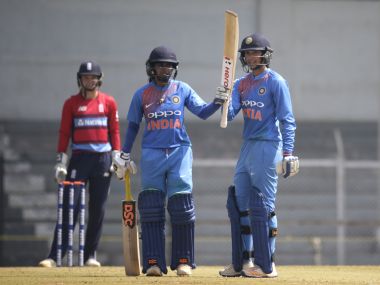There has been a pattern developing over the last few matches that the Indian women’s cricket team have played. Crowd turns up. India bat. Smriti Mandhana provides a start. Mandhana gets fifty. Mandhana gets out. India collapse. India lose. Crowd departs. Sunday, at the Brabourne Stadium, was slightly different. Mandhana provided the same flying start that she can now claim IP rights to. Only, it was better. She raced to her highest T20I score of 76 off just 40 balls. She helped India to their highest T20I score of 198. There was a wobble in the middle, sure. But 32 runs came off the last two overs, so it wasn’t shambles. [caption id=“attachment_4405827” align=“alignleft” width=“380”] Smriti Mandhana, right, celebrates her fifty with Mithali Raj against England. AP [/caption] Then came the steamrolling that has become all too familiar this series. Thanks to Danielle Wyatt’s second T20I century in as many series, England won by seven wickets. Crowd departs. *** Watching Mandhana bat in this series has been like watching a child successfully solve a Rubik’s cube, much to the mystification of all the adults watching. It seems like she knows the code, one that others are yet to decipher. Mandhana has looked dominant against two of the top sides in the world. But just as discordant has been the performance of the other batswomen around her; the next most runs in the ODI series belonged to India’s No 9, and in the T20Is, the next Indian has less than half her tally so far. In the ODIs against Australia, Mandhana’s approach was simple: hit boundaries while the field was up, then take singles once it was spread. There was no in-between, no attempt to steal singles off good balls by playing with soft hands. It was one-dimensional, but effective batting. It meant that she scored 73 percent of her runs in boundaries. For the first 10 overs, that percentage went up to 81. Unimaginative, but pretty when she timed it, stunning when she applied her considerable strength. What it did, though, was help fight the Australians on their own terms, taking the attack to them. Partly that was born of necessity; she was chasing scores of 288 and 333 in the last two ODIs. Nonetheless, the blitz-then-bunt plan has been her friend in the T20Is. In two games, she already has 131 runs, at a strike rate of 176.5. More than the shots, it has been the awareness of the shot-clock that has been impressive. Australian vice-captain Rachael Haynes spoke about how important the first six overs were for her team. “We definitely want to target the powerplay, especially in these conditions, when you’ve got some players who can clear the infield with ease." she said. “We want to see how far we can push it; it’s definitely an area where we think we can gain an edge.” Alert to this, Mandhana has upskilled quickly, not hesitating to go over infields. On wickets that need no tar and gravel to be called roads, her early aggression has taken India to powerplay scores of 47 and 52 in the two games, with 66 percent of those runs coming off her bat. Most impressive has been her intrepid nature of her shot making; she has been unbridled by the fear of what may happen should one of her risks fail to come off. On Sunday, it earned her the fastest fifty for an Indian, and joint fourth-highest overall, coming off just 25 balls. Her form is a stark turnaround from last year, where she had seven failures after a blistering start at the World Cup. In the seven-month gap between then and India’s next assignment, Mandhana went back to the drawing board and made a minor change in her technique. Largely considered an off-side player with a mean pull shot, she opened up her stance a fraction, allowing her better access to the on side. This has helped her manipulate the one-sided fields that captains use in powerplays. While her top-gear consistency is welcome news for India, the lack of such urgency from the other batswomen is disconcerting. Mithali Raj and Harmanpreet Kaur always start tepid before they blow hot, but the ODI series saw them fall before they could convert their starts to big scores, hurting the team’s run rates. On Sunday, when they both did score substantially, they were guilty of going too slow: Raj (53 off 43) opened, then took 26 balls to get up to a run-a-ball; Harmanpreet (30 off 22) batted in the dying stages of the game and took 15. But the women’s game has left the slow starters behind, at least in T20. “Especially out here, you need to be pushing the scoring rate really quickly and you don’t have a lot of time to get in," said Australian captain Meg Lanning. As the two most experienced batswomen in the team, Raj and Harmanpreet need to adapt faster, as do the rest of the players. Mandhana’s scores at home so far are 12, 67, 52, 67, and 76. At the time of writing, she is the top run-getter in the series. In both her last T20 innings, she has improved on her personal best. No doubt Mandhana will want to break the pattern of fifties coming in losing causes. The scary part for India — what pattern will emerge if she has a bad day? The author is a former India cricketer, and now a freelance journalist and broadcaster. She hosts the YouTube Channel, ‘
Cricket With Snehal’, and tweets
@SnehalPradhan
Smriri Mandhana’s early aggression has taken India to powerplay scores of 47 and 52 in the first two games, with 66 percent of those runs coming off her bat.
Advertisement
End of Article


)

)
)
)
)
)
)
)
)



